Stovetop BIAB Brew Day – Franklin Centennial IPA
As I started my homebrewing adventure last year using extract, I knew the end goal would be to eventually move into all grain brewing. Living in an apartment, I thought this would be something that I’d be putting off for quite some time as traditional three vessel brewing takes up a lot of space, both while brewing and in storage. This was before I found out about the brew in a bag method, or BIAB. Essentially, this lets you use just one vessel to mash, sparge, and boil in, saving space and time. After doing some reading, it looked like BIAB was going to be a great way to move beyond extract into all grain brewing, and all I needed to step up was a large bag and an extra stock pot. This second stock pot was more for convenience than a necessity, but I decided to go for it. So, how can one brew a full all grain batch on their stove? Here’s how I went at it.
Before I get into this, I want to point out that I brew 2.1 gallon batches rather than the usual 5. This way I save space in my apartment while fermenting, and can
actually do a full boil on my stove. If you’re doing a 5 gallon batch, you’ll most likely need to add water to your fermenter at the end to bring your batch up to full volume.
To do a full BIAB on the stove, not much more than your extract equipment is needed. In fact, just get a fine mesh bag large enough to line your pot and you’re good to go. I use a second stock pot, which you’ll see why later, but it isn’t completely necessary. The usual sanitizer and fermenter are required obviously, but the only thing you’ll really need to add from your extract set up is the bag. In my explanation below, I’ll be including directions on BIAB sparging.
Now, on to the actual brewing. Here’s the breakdown and recipe for my Franklin Centennial IPA that I brewed:
Projected OG: 1.058
Actual OG: 1.057
Projected FG: 1.016
Actual FG: 1.014
ABV: 5.51%
IBU: 59.2
SRM: 8°
Ingredients
- 4 lbs – 2 row
- 12 oz – Crystal 20L
- 60 min – 1/4 oz Centennial
- 30 min – 1/4 oz Centennial
- 15 min – 1/2 oz Centennial
- Dry hop – 1 oz Centennial, 4 days
The first thing you need to do is calculate the amount of water you’ll need for the mash, and get that heated up to the right strike temperature. This is a good calculator to use , but if you want to calculate it yourself a good number to use is 1.3 qt/lb of grain. So, get your water heated up to the appropriate strike temperature (about 10 degrees above what you want to mash at,
which for this brew it was 164°F to mash at 154°F), and slowly dump the grain in, making sure it all gets soaked. Check your temperature, stirring if it’s too high and turn on the burner to heat the mash up if your temperature is too low. Make sure the bag isn’t touching the bottom of the pot so it doesn’t scorch; I use binder clips to hold the bag in place.
Once you’ve got the mash going, let it sit for at least 60 minutes. This will allow the enzymes to break the starch down into the sugars that will later be converted to alcohol. About half way through the mash, start heating up your sparge water in the second pot. This step isn’t absolutely necessary for the BIAB method, but it does help get a better efficiency. You’ll use this water to sparge with if you choose.
Get the sparge water heated up to about 175°F, which will then drop to just under 170°F when you move the grain bag into the pot. You want to stay under 170°F so as to not extract unwanted tannins, which can affect the taste of your finished beer. Once your mash is complete, pull the grain bag out of the mash water and let it drain. Twist the
bag, squeeze it, whatever you want to do to satisfactorily drain the grains. Put the grain bag into the sparge pot, and let it sit there at a steady temperature right around 170° for 10-15 minutes. This will essentially rinse the grains, getting more wort for your boil. Once the time has elapsed, drain the bag again, and pour enough sparge water into your original pot to bring you to your preboil volume. Once you’re there, brew as normal with your hop additons, cooling, and pitching.
There you have it – all grain brewing on the stove in your own kitchen. I can honestly say that I noticed an immediate improvement in the taste of my first all grain batch compared to a similar recipe I had done using extract. Gone is that extract twang, and in its place is a really tasty homebrewed beer.
Follow @dasalehaus- The spent grain – still useful for making bread and other edibles.
- My original gravity came out almost dead on – just .001 off.
- Whirlfloc doing its thing.

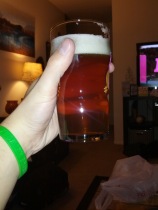
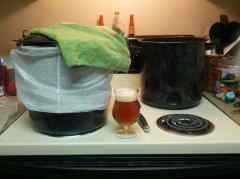
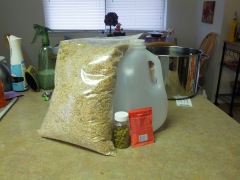
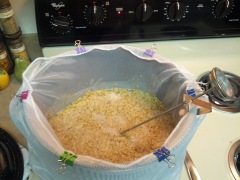


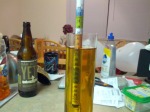
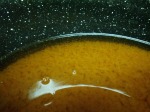
Nice write up. This is a method I have been wanting to try. Did you notice any loss of temperature during the 60 minute mash? Did you periodically add heat during the mash to compensate?
There was a couple degree drop, but this is using a Granite Ware pot rather than steel or aluminum, which apparently loses heat a lot quicker. The key was leaving it alone, rather than trying to mess with it and get it perfected. I have an electric stove, so it was way too finicky to try and mess with. If I remember correctly, the last time I did this it dropped from about 154 to 151.
Pingback: Brew Review: 2013 Atlantic City Beerfest | Das Ale Haus
Pingback: Homebrewing Hack – Insulation | Das Ale Haus
Pingback: Homebrew Review: Catching Up | Das Ale Haus
Pingback: Brewtiful Disaster | Das Ale Haus
Thanks for the great writeup. One idea to throw in: I set my oven to 154°F and put the whole brew pot in for the mash. Worked like a charm!